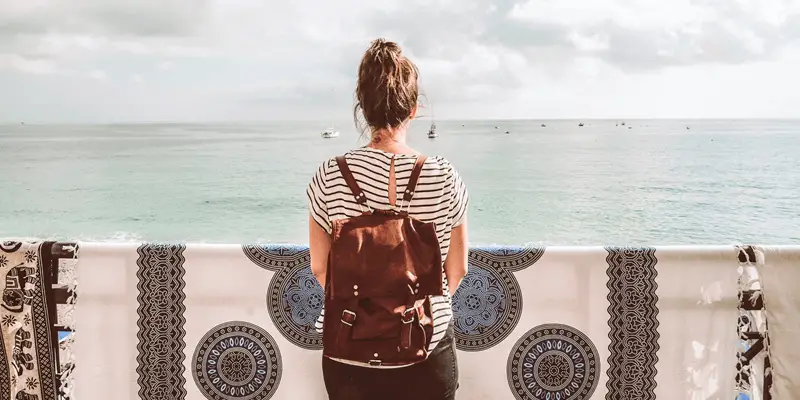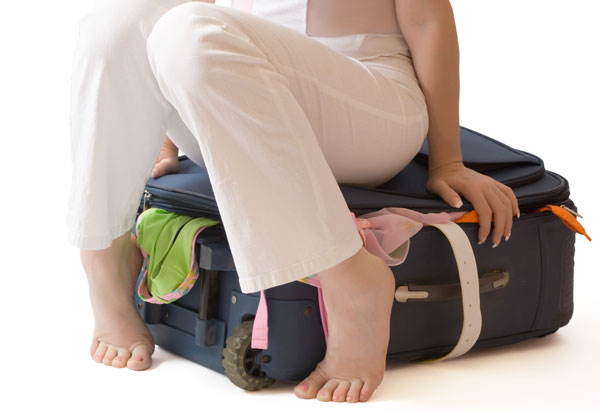Embarking on a journey, whether across continents or just a weekend getaway, demands a reliable companion to carry your essentials with ease and efficiency.
The choice of a backpack can significantly impact your travel experience, influencing comfort, organization, and overall convenience.
As the market offers a myriad of options, selecting the best backpack for traveling requires careful consideration of factors such as size, durability, design, and functionality.
In this exploration of the finest travel companions, we will delve into the features that make a backpack stand out and recommend some of the top choices that cater to the diverse needs of modern-day adventurers.
Whether you’re an avid globetrotter, a digital nomad, or a casual explorer, finding the perfect travel backpack is an essential step toward enhancing your on-the-go lifestyle.
1. Types of Travel Backpacks

Daypacks:
Daypacks stand as the perfect companions for short trips and day excursions. These backpacks are characterized by their lightweight and compact design, making them ideal for carrying essentials during city explorations or quick outdoor escapades.
With a focus on portability and convenience, daypacks are an essential component for travelers seeking a nimble and agile solution for their short-term adventures.
Hiking Backpacks:
Tailored for trekking and outdoor adventures, hiking backpacks prioritize durability and support. These robust companions are designed to withstand the rigors of nature, featuring reinforced materials and supportive structures that distribute weight evenly.
Whether navigating challenging terrains or embarking on an extended hiking excursion, these backpacks ensure that adventurers can rely on their gear for stability and resilience in the face of diverse outdoor conditions.
Travel Backpacks:
For longer journeys and multi-day trips, travel backpacks emerge as versatile solutions catering to various travel needs.
These backpacks are crafted with an array of features to accommodate the demands of extended travel, combining ample storage space with organizational compartments.
From dedicated laptop sleeves for digital nomads to expandable sections for souvenirs, travel backpacks are designed to enhance convenience and adaptability, making them an integral part of the discussion on the best backpacks for traveling.
2. Key Features to Consider
Size and Capacity:
Matching backpack size with trip duration:
Tailoring the size of your backpack to the duration of your trip is crucial for efficient packing. Whether it’s a weekend getaway or an extended journey, selecting the appropriate size ensures you have sufficient space without carrying unnecessary bulk.
Determining appropriate capacity for belongings:
Understanding the capacity needs of your travel essentials is vital. Assessing the volume required for clothing, electronics, and other items helps prevent overpacking and promotes organized storage.
Comfort and Fit:
Importance of ergonomic design:
Opting for a backpack with an ergonomic design is essential for long hours of wear. This ensures that the weight is distributed evenly, reducing strain on your back and shoulders.
Adjustable straps, padded back, and hip belt considerations:
Customizable features like adjustable straps and a padded back enhance comfort, while a hip belt helps distribute weight, particularly important during extended periods of wear.
Durability and Material:
Choosing sturdy materials for different travel conditions:
The durability of your backpack is paramount, especially for frequent travelers. Selecting sturdy materials, such as high-denier nylon or polyester, ensures resilience against the demands of various travel conditions.
Weather resistance and durability against wear and tear:
Investing in a backpack with weather-resistant features shields your belongings from unexpected elements. Additionally, considering resistance to wear and tear ensures your backpack withstands the challenges of constant use.
Security Features:
Anti-theft mechanisms:
Security is a top priority for travelers. Backpacks with anti-theft mechanisms, such as lockable compartments or hidden pockets, provide an added layer of protection against pickpockets and unauthorized access.
Lockable zippers and RFID-blocking compartments:
Features like lockable zippers and RFID-blocking compartments further enhance security. Lockable zippers deter theft, while RFID-blocking technology protects your electronic data from unauthorized scanning, making these considerations pivotal when evaluating the best backpacks for traveling.
3. Top Picks for Travel Backpacks

Brand 1:
Highlighting key features:
Brand 1 emerges as a standout choice for travel backpacks, boasting a combination of innovative features. From smart organizational compartments to durable materials, this brand prioritizes functionality without compromising on style.
Notable features include multiple access points, weather-resistant materials, and specialized pockets for seamless organization on the go.
User reviews and testimonials:
The acclaim from users reinforces Brand 1’s reputation as a top contender. Positive testimonials highlight the durability, comfort, and overall satisfaction experienced by travelers.
Real-world experiences provide valuable insights into the performance and reliability of these backpacks, solidifying Brand 1’s position as a reliable choice for discerning travelers.
Brand 1:
Unique selling points:
Brand 2 distinguishes itself with unique selling points that cater to the diverse needs of travelers. Whether it’s an emphasis on sustainable materials, cutting-edge design, or innovative security features, Brand 2 positions itself as a trendsetter in the travel backpack market.
The incorporation of tech-friendly elements, such as built-in USB ports for charging devices, sets Brand 2 apart in the competitive landscape.
Comparison with other brands:
When compared with other brands in the market, Brand 2 excels in certain aspects. A side-by-side analysis reveals how its features stack up against competitors, emphasizing superior durability, enhanced security measures, or advanced ergonomics.
This comparative approach aids travelers in making informed decisions, ensuring they find a backpack that aligns perfectly with their unique preferences and requirements.
4. Budget-Friendly Options
Affordable backpacks that still offer quality:
When exploring the realm of travel backpacks, cost-conscious travelers seek options that deliver quality without breaking the bank.
Several brands have risen to the challenge, offering affordable backpacks that maintain a high standard of craftsmanship.
These backpacks are designed to endure the rigors of travel while remaining accessible to a broad range of budgets.
Value for money and cost-effective choices:
The quest for the best travel backpack doesn’t always necessitate a hefty price tag. Value for money becomes a pivotal consideration, and budget-friendly options often surprise with their impressive features.
From durable materials to thoughtful design elements, these backpacks provide an economical yet reliable solution, ensuring that travelers receive optimal functionality without compromising on quality.
Consideration of budget constraints:
Recognizing the importance of budget constraints, this section delves into backpack options that align with various financial considerations.
Whether planning a shoestring adventure or simply aiming for a cost-effective solution, budget-friendly travel backpacks cater to diverse needs.
Emphasizing affordability doesn’t mean sacrificing essential features, as these options maintain a delicate balance between cost and performance.
5. Tips for Packing a Travel Backpack

Efficient organization strategies:
Utilize packing cubes and pouches: Invest in packing cubes to compartmentalize clothing and accessories. These cubes not only keep items organized but also make it easy to locate specific items without rummaging through the entire backpack.
Rolling vs. folding: Experiment with different packing techniques. Rolling clothes can save space and reduce wrinkles, while folding may work better for bulkier items. Finding the right balance between the two can optimize space and organization.
Maximizing space and minimizing weight:
Prioritize essentials: Identify and pack only the essentials to minimize weight. Consider the climate and activities at your destination to streamline your packing list.
Choose lightweight and compact gear: Opt for travel-friendly items that are both lightweight and compact. From portable toiletries to collapsible water bottles, selecting gear with space-saving features contributes to efficient packing.
Packing tips for specific types of trips:
City exploration: Pack versatile clothing suitable for diverse urban activities. Consider the cultural norms and weather of the destination to tailor your wardrobe accordingly.
Outdoor adventures: For hiking or outdoor excursions, prioritize durable and weather-resistant gear. Pack essentials like a first aid kit, a compact camping stove, and appropriate layers for varying temperatures.
Business travel: Organize work-related items efficiently, such as laptop, documents, and chargers, in dedicated compartments. Choose a backpack with a professional aesthetic that can seamlessly transition from meetings to exploration.
6. Maintenance and Care
A. Cleaning and preserving the backpack:
Regular cleaning routine: Establish a regular cleaning routine to remove dirt, stains, and odors. Wipe down the exterior with a damp cloth, and if the backpack is machine washable, follow manufacturer instructions for cleaning.
Emptying and airing out: Empty the backpack after each use to prevent lingering smells and potential mold growth. Allow it to air out thoroughly before storing.
Repairing common issues:
Zipper maintenance: Keep zippers running smoothly by periodically applying a zipper lubricant or wax. If a zipper becomes stuck, avoid forcing it and instead gently realign the teeth.
Patch small tears and frays: Address small tears promptly with patching materials or fabric glue to prevent them from worsening. Regularly inspect seams and straps for any signs of wear.
Extending the lifespan of the backpack:
Proper storage: Store the backpack in a cool, dry place to prevent mold and mildew growth. Avoid leaving it in direct sunlight for extended periods to prevent color fading and material damage.
Avoid overloading: Stick to the recommended weight capacity to prevent undue stress on zippers, straps, and seams. Distribute weight evenly to maintain the backpack’s structural integrity.
Related Topics:
Conclusion
In the realm of travel, the significance of selecting the best backpack cannot be overstated. As we navigate the myriad options available, considerations ranging from size and durability to unique features and budget constraints come into play.
The exploration of various types, key features, and top picks reveals a diverse landscape catering to the dynamic needs of modern travelers.
The backpacks highlighted for their quality, affordability, and innovative designs stand as indispensable tools for any adventurer.
Yet, the journey doesn’t end with the acquisition; meticulous maintenance and care ensure these companions endure the rigors of exploration.
Ultimately, the best backpacks for traveling seamlessly integrate into the wanderer’s lifestyle, becoming not just storage solutions but reliable partners in the pursuit of new horizons, cultural discoveries, and memorable experiences.
As we embark on our journeys, the right backpack becomes a symbol of preparedness, adaptability, and the gateway to a world of endless possibilities.
FAQs
What should I consider when choosing a travel backpack?
Consider factors such as size, capacity, comfort, durability, and security features. Assess your specific travel needs and preferences to find the best fit.
Are there different types of travel backpacks for various purposes?
Yes, there are different types, including daypacks for short trips, hiking backpacks for outdoor adventures, and travel backpacks for longer journeys. Each type caters to specific travel requirements.
How important is the size and capacity of a travel backpack?
Size and capacity are crucial considerations. Choose a size that aligns with your torso length and a capacity that accommodates your belongings. Match the backpack to the duration and type of your trip.

2 thoughts on “What Are The Best Backpacks For Travelling”